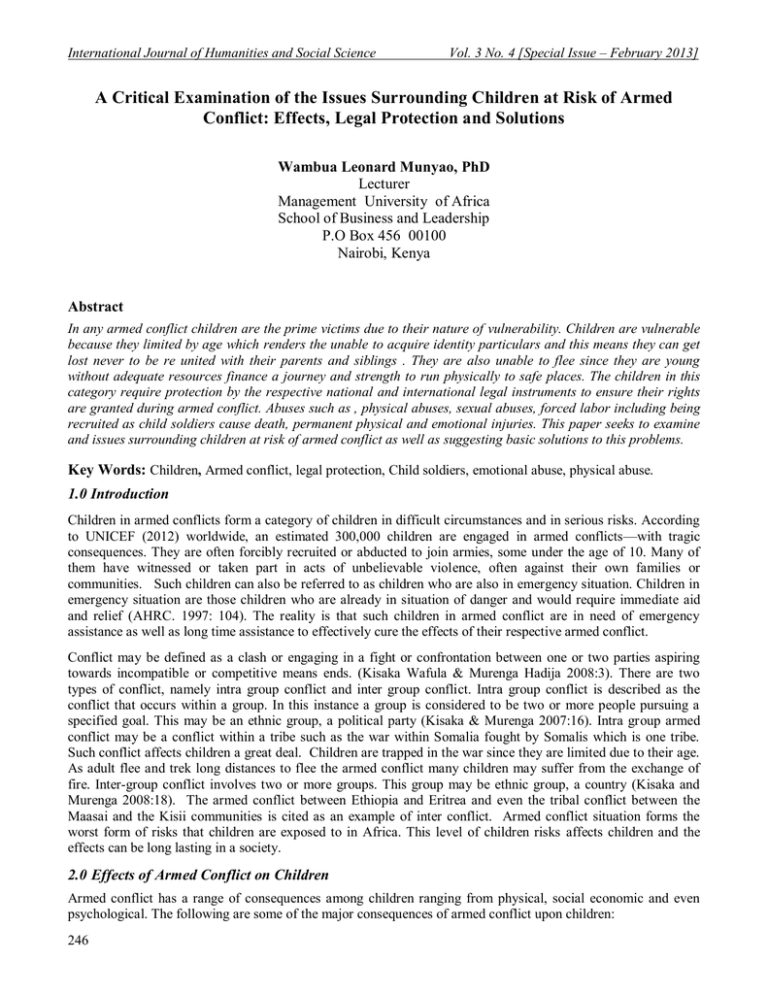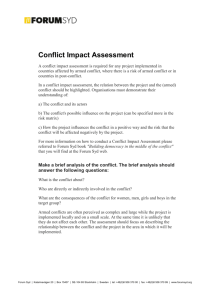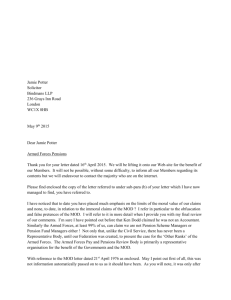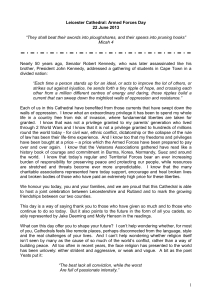
International Journal of Humanities and Social Science
Vol. 3 No. 4 [Special Issue – February 2013]
A Critical Examination of the Issues Surrounding Children at Risk of Armed
Conflict: Effects, Legal Protection and Solutions
Wambua Leonard Munyao, PhD
Lecturer
Management University of Africa
School of Business and Leadership
P.O Box 456 00100
Nairobi, Kenya
Abstract
In any armed conflict children are the prime victims due to their nature of vulnerability. Children are vulnerable
because they limited by age which renders the unable to acquire identity particulars and this means they can get
lost never to be re united with their parents and siblings . They are also unable to flee since they are young
without adequate resources finance a journey and strength to run physically to safe places. The children in this
category require protection by the respective national and international legal instruments to ensure their rights
are granted during armed conflict. Abuses such as , physical abuses, sexual abuses, forced labor including being
recruited as child soldiers cause death, permanent physical and emotional injuries. This paper seeks to examine
and issues surrounding children at risk of armed conflict as well as suggesting basic solutions to this problems.
Key Words: Children, Armed conflict, legal protection, Child soldiers, emotional abuse, physical abuse.
1.0 Introduction
Children in armed conflicts form a category of children in difficult circumstances and in serious risks. According
to UNICEF (2012) worldwide, an estimated 300,000 children are engaged in armed conflicts—with tragic
consequences. They are often forcibly recruited or abducted to join armies, some under the age of 10. Many of
them have witnessed or taken part in acts of unbelievable violence, often against their own families or
communities. Such children can also be referred to as children who are also in emergency situation. Children in
emergency situation are those children who are already in situation of danger and would require immediate aid
and relief (AHRC. 1997: 104). The reality is that such children in armed conflict are in need of emergency
assistance as well as long time assistance to effectively cure the effects of their respective armed conflict.
Conflict may be defined as a clash or engaging in a fight or confrontation between one or two parties aspiring
towards incompatible or competitive means ends. (Kisaka Wafula & Murenga Hadija 2008:3). There are two
types of conflict, namely intra group conflict and inter group conflict. Intra group conflict is described as the
conflict that occurs within a group. In this instance a group is considered to be two or more people pursuing a
specified goal. This may be an ethnic group, a political party (Kisaka & Murenga 2007:16). Intra group armed
conflict may be a conflict within a tribe such as the war within Somalia fought by Somalis which is one tribe.
Such conflict affects children a great deal. Children are trapped in the war since they are limited due to their age.
As adult flee and trek long distances to flee the armed conflict many children may suffer from the exchange of
fire. Inter-group conflict involves two or more groups. This group may be ethnic group, a country (Kisaka and
Murenga 2008:18). The armed conflict between Ethiopia and Eritrea and even the tribal conflict between the
Maasai and the Kisii communities is cited as an example of inter conflict. Armed conflict situation forms the
worst form of risks that children are exposed to in Africa. This level of children risks affects children and the
effects can be long lasting in a society.
2.0 Effects of Armed Conflict on Children
Armed conflict has a range of consequences among children ranging from physical, social economic and even
psychological. The following are some of the major consequences of armed conflict upon children:
246
The Special Issue on Contemporary Issues in Social Science
© Centre for Promoting Ideas, USA
2.1 Children engaging in war as children solders
A child solder is any girl or boy child below 18 years who is part of any kind of regular or irregular armed force
or armed group. (Cradle 2007:2) Children who join the armed forces to serve as cooks, porters, messengers and as
companions where the child is not a family member to the group are also categorized as child soldiers.
(CRADLE, 2007:2). Children who engage in armed conflict are denied the right of protection from armed
conflict. They are also exposed to all manner of abuses. Children are not able to make proper choices since their
age is not allowing them to do so.
2.2 Displacement
Armed conflict causes children to run to other countries where they become refugees (CRADLE, 2007:2).
Children who are refugees are denied the basic rights that should be provided by their governments. Many
children who grow up in refugee camps lack the important values of their communities, their culture is interfered
with, and the very young ones are not socialized as they should be, in their normal home country environment.
Many children suffer other tragedies and violations of their rights such as child labour. Child trafficking takes
place among the children of refugees since they are more vulnerable.
2.3 Loss of life
Thousands of children are killed every year as a result of fighting from knives, bullets, bombs and landmines.
Mwiti ( 2006:55) emphasizes the same by citing the following categories of war related deaths:
Deaths caused directly by military action such as when a child is caught in crossfire or when a whole family
is wiped
Death caused by hunger and starvation since during war especially in countryside, food production is
disturbed or made impossible.
Death caused by malnutrition, diarrhea and many diseases which go untreated, affecting mostly infants and
children under five.
UNICEF (as quoted by Mwiti 2006:56) points out that in 1986, 140,000 children died in Mozambique and
Angola wars. Armed conflict is a major threat to children lives, since children are always the most vulnerable
when war breaks out.
2.4 Worst form of Child Labour
Armed conflict can result to the worst form of child labour. This occurs when children are abducted during wars
to serve as child soldiers. In Liberia war, many children were forced to join the war and fight at the battle front.
(Bonnerjia Lucy 1994:13). It is estimated that during the second world war more than a million children were
deported as slaves while others were abducted for the Nazi adoption programme. (Bonnerjia 1994:13) Most of
these abducted children who suffer child labour are also victims of other forms of child abuse since they are not
under any watch.
2.5 Separation
During armed conflict, children are separated from their parents or guardians. They are therefore denied the home
or family environment which is the best. The following statement emphasizes the same:
“Family tracing is based on the belief that most of the time, families are best for children. Families are
thought to be best environment for the development of children” (Bonnerjia 1994:22)
During the war children are lost while fleeing from attacks while others may be abandoned because either the
parent or the child is thought too weak to carry on. During the Vietnam war by 1973 5000 children who had been
separated or lost their parents through death lived in unregistered places both in appalling conditions. Some
children who get lost during war never get to find their parents, they end up being adopted or growing up as
slaves among some captors. (Bonnerjia1994:29)
2.6 Loss of parents through death
Many children are orphaned during armed conflicts. Children end up growing up orphans. In Liberia armed
conflict many children even witnessed the physical killing of their parents. (Bonnerjia 1994:13).
247
International Journal of Humanities and Social Science
Vol. 3 No. 4 [Special Issue – February 2013]
During the Vietnam war it is estimated that over 20,000 children lived in registered orphanages. (Bonnerjia
1994:16) In a UNICEF survey, of 3,030 children in Rwanda in 1995 nearly 80% had lost immediate family. The
conflict in Rwanda affected children by making many of them orphans, the following stresses the same:
“The genocide has deeply bruised the Rwanda society by creating tens of thousands of orphans,
widows and women led families, either because men are killed or they are outside the country or
in prison. A survey carried in November 1995, before the return of new refugees demonstrated
that two children per family were orphans. There are many households headed by children”
(ACDESS, 1999:165)
The above statement further reveals effects of being orphaned on children, effects such as children taking
responsibilities of adults to head homes since their parents are dead. During Mozambique’s 16 year old war it is
also estimated that 200,000 children were orphaned or abandoned by adults. (CCPD:20) The pain of losing
parents affects children socially and emotionally since they lack the most important care, parental care and love.
2.7 Physical Injury
War affects children physically. Many of them on addition to suffering suffer effects associated with war such as
malnutrition and starvation, they also suffer physical injuries. During armed conflicts children also suffer effects
of landmines and unexploded ordinance. Many children who are unable to notice suffer death or loss of limbs as
legs or loss of hands among other permanent body injuries. (cradle, 2007:3). Such children are unable to seek
better treatment during armed conflicts. Effects of landmines left after war are longtime since some of the
landmines affect playing children even long after the war.
2.8 Sexual Abuse
During armed conflict, children suffer all manner of sexual abuses. Cradle (2007:2) points out that during armed
conflict, it is a common practice to have girls and boys recruited for sexual purposes or for forced marriage, or
girls taken as sex slaves. The following statement by Human Rights Watch (1996:58) explains the point better:
“In one case, a militia leader in the commune of Kigarama paraded out young men to members
of his militia group who had performed their killing responsibilities particularly well. In a bizarre
“marriage” ceremony, the militia leader officiated over four marriages of young girls between
the ages of sixteen and nineteen years to members of militia group”
Armed conflicts are therefore a source of multiple categories of sexual abuse ranging from early marriage, child
sex slaves, rape and forced marriage. The effects of sexual abuse can be life long if not addressed appropriately.
2.9 Disruption of Education Services
Education is one of the key development rights of children, that is adversely disrupted during armed conflict.
During the Mozambique war, it is estimated that at least 10,000 children served as soldiers during the war. This
implies that these children had stopped going to school to serve as child soldiers. It is also estimated that over
40% of the schools in Mozambique were destroyed during the war (CCPDC 1998:20). The effect of war on
children’s education are also felt when teachers are killed or injured and schools becoming impossible to access
due to prolonged armed conflict.
2.10 Emotional & Physical Sufferings
Armed conflict affects children by inflicting damage that goes beyond physical, to emotional and psychological
damage. Children who are forced to carryout murder, children who witness death of their relatives such as parents
and those that suffer effects of sexual abuse are left badly traumatized. Human Rights Watch (1996:58) explains
the point better in the following statement:
“Young girls were not spared from being held in this manner. Nadia was still traumatized two
years later. In a tearful interview during which she barely looked up, she described her
experience of being raped, while only eleven years old”
The experiences of Nadia as described by Human Right Watch, highlight the trauma suffered by children in
armed conflict situation. Human Right watch (1996:58) further show how the 11 year old girl on addition to
enduring rape ordeal on the hands of militia in Rwanda witnessed the hacking to death of brother and parents who
were hacked into pieces in her presence.
248
The Special Issue on Contemporary Issues in Social Science
© Centre for Promoting Ideas, USA
Children are also arrested and detained or taken to prison. Some are taken away as war prisoners especially those
engaged as combatants. This children suffer torture some of them resulting to life long psychological
disturbances. This children are also held with adults in prison and as war prisoners (UNICEF 1993:105)
3.0 Legal Protection of Children in armed conflict situation
Children at risk of armed conflict situation are protected under different international legal instruments and even
national laws. The following are examples of the explained protection measures.
3.1 United Nations Convention on the Rights of the Child
CRC Article 38 provides that state parties are to take all feasible measures to ensure children under 15 years of
age have no direct part in hostilities. The convention further exhorts state to ensure children below 15 years of age
are not recruited to armed forces as well as ensuring the care and the protection of children affected by armed
conflict. (AHRC,1997) Article 39 of CRC also obliges states parties to ensure that child victims or armed
conflicts receive appropriate treatment for their recovery and social integration.(CRADLE, 2007:5)
3.2 African Charter on the Rights of the Child
The ACRC provides for the extension of rules on international humanitarian law (law of war) applicable in armed
conflicts to children. Additionally ACRC provides that no child under 18 years of age is to be recruited in any
armed group or take part in hostilities (CRADLE 2007:5)
3.3 The Optional Protocol (To the United Nations Convention on the Rights of the Child)
The optional protocal makes provision that no person under 18 years shall be subject to compulsory recruitment
into regular armed forces. (CRADLE, 2007:5). The Optional Protocol further imposes an obligation on state
parties to raise the recruitment to at least 16 years of age (CRADLE, 2007:5).
3.4 The International Labour Organization Convention of 1999 on Elimination of the Worst Type of
Labour
This convention prohibits the forced or compulsory recruitment of children under 18 years for use in armed
conflict (CRADLE 2007:5).
3.5 The Statute of the International Criminal Court (Rome Statue)
The ICC Statute which entered force in 2002 makes the conscription enlisting or use in hostilities of children
under 15 years of age by national armed forces or armed group a war crime. (CRADLE, 2007:8). The Statute
further defines rape, sexual slavery, forced prostitution, forced pregnancy, or any other form of sexual violence or
comparative gravity as crime against humanity and war crimes. (CRADLE, 2007:8)
3.6 Children Act Chapter 508 of the Laws of Kenya
The Chapter of the Kenyan Law provides against the use of children in armed conflict and it also provides for
rehabilitation of children involved in armed conflict and it also provides for rehabilitation of children involved in
armed conflict. ( CRADLE,2007:8)
3.7 Some African Traditional Laws
As argued by Kisaka and Murenga (2008:73), children were viewed as a gift from God and the innocent lifelines
of society. It was therefore viewed as a bad omen to harm children during armed conflict. It is said that children
and women of Kalenjin and Kisii communities, would during conflict cross over to the enemy land and be fed and
accommodated (Kisaka and Murenga 2008:73).
It is therefore clear that in Africa Culture, it is unethical to harm children during wars. Women also were not
attacked during armed conflict, a practice that enhanced child survival , since the child would not lose both
parents in case of death the male parent. Although children and women were spared, it was a common practice
among some communities to have women and children taken as slaves or even into forced marriage during armed
conflicts.
249
International Journal of Humanities and Social Science
Vol. 3 No. 4 [Special Issue – February 2013]
4.0 Practical Suggestions for Responding to the Children Victims of Armed Conflicts
During armed conflicts, all the stakeholders, the governments or the groups engaged in war are legally bound to
take seriously the best interest of the child during armed conflict. The following are some of the essential
measures to be put in place during and after the armed conflict.
Ensuring safety of Children during after armed conflict
During armed conflict each opposing party should avoid situations which endanger children and women in
crossfire (UNICEF,1993:60). Precaution should be taken to avoid a situation whereby children are attacked either
at home, at school or even in hospitals. To ensure their safety, the communities at war should look for ways to
ensure the continuous flow of goods and services in their respective areas. Inability to access food, medical
services and water during armed conflict affects children in a more serious way. During armed conflict, the state
should provide shelter, clothing, etc (AHRC 1997:105).
Expectant and Nursing Mothers should be given extra Care and Protection. (AHRC 1977:105).
This should be done because during armed conflict children and expectant mothers may be neglected by the state.
Services such as vaccination, pre-natal and anti-natal clinic may not be attended during armed conflict. Diseases
such as polio, and other infections may affect children. Weapons that affect children and expectant mothers such
as dangerous chemicals and biological weapons should be avoided.
Care for the Arrested Children
During armed conflict, children may be arrested. UNICEF (1993:61) points out that children arrested for any
reason related to armed conflict are entitled to the following special rights:
Separate detention from adults except where families are accommodated as a family unit,
Immediate free legal assistance,
Immediate notice of such arrest to parents or guardians of the child,
Release of the child on recognizance within twenty four hours to the custody of the department of social
welfare and development or any responsible member of the community as determined by the court.
Children in colision with the law during armed conflict therefore deserve care, as any other children. It is even
recommended that specific offences such as capital offences should not be awarded to offenders who are under 18
years of age.
Psychosocial Support
Victims of armed conflict children who have experienced different level of pains associated with armed conflicts
should be accorded psychosocial support to enable them live normal life. CRADLE ( 2007:10) suggest that
children victims of armed conflict should be given counseling or psycho social support which should include
reintegration and healing or forgiveness rituals. Children who have undergone rape, witnessed murder or even
engaged in killing as child soldiers will need professional counseling services to reduce trauma and effect internal
healing. NGOs, government agencies and even community based organizations should be equipped with relevant
psychosocial support skills to participate in assisting children to recover from war trauma.
Provision of Education
Children are denied education as a result of breakdown of education institutions during armed conflicts. There
should be a special program to ensure schools are opened and children are back to schools. Those in refugee
camps or settlement for internally displaced persons should be assisted to access free education. CRADLE
(2007:10) points out that a special plan to promote secondary education and life skills training should be part of a
countries healing strategy for post conflict countries. Governments and Non Governmental Organizations
including faith based organizations should be able to play a major role. They should provide education and carry
out advocacy to encourage state to provide free education. The international donor agencies like UNICEF, FAO,
UNDP among others should seek to assist the affected countries to attain quick recovery and fund them to offer
education
250
The Special Issue on Contemporary Issues in Social Science
© Centre for Promoting Ideas, USA
Availing Health Services
Children who are victims of war suffer psychological and physical injuries. Donor agencies and NGOs such as
Red Cross and even health providing NGOs should avail medicine for the camps where refugees are settled.
Children vaccination services should provided freely and even those girls and boys who are rape victims should
get medical assistance. Child soldiers should also be released to civilian for provision of health care (CRADLE,
2007:9)
Training of Military Personnel on their Legal Responsibilities to Women and Children
Most military personnel commit act of violence against children and women without knowing they have a
responsibility of protecting them. The military training should ensure the training curriculum addresses the
protection of children rights during armed conflict. This training should extend to the military police and the
regular police who investigate crimes especially rape, committed against women and children. The following
echoes the some idea:
“The Ministry of Justice should ensure that all police inspectors receive mandatory training on
the issue of rape and other sexual abuse, including their status as crimes punishable by law.
Specifically we urge that police inspectors investigating genocide crimes, receive training to
ensure that discriminatory attitudes about female victims of sexual abuse do not prevent serious
investigations of sexual abuse or undermine its effective prosecution” (Human Watch, 1996:8)
Training of military personnel should go hand in hand with sensitizing communities on their role to protect
children during armed conflict. Community based organizations should be utilized to train and sensitize
communities on the rights and vulnerability of children and women during armed conflict.
Prosecution of Abusers of Children
The International Tribunal must fully and fairly investigate and prosecute sexual violence against children and
women. (Human Watch ,1996:9). This prosecution should extend to those who are children in armed conflict.
Militia leaders who engage in such actions should be arrested and brought to justice. Governments should enact
laws that punish offenders who commit abuses against children and women. Penalties must be stiff enough to
deter repeat of the crimes against children.
Reunification of Children Separated from Parents during Conflict
As stated before, during war children are lost while fleeing from attacks while others may be abandoned because
either the parents or the child is thought to be weak to carry. This means during war many children are lost. There
should be efforts to trace the abandoned children (Bonnerjea 1994:29). Bonnerjea ( 1994:23) emphasizes the
importance of returning children to their parents:
“Families are thought to be the best environment for the development of the child, the long term
future of the child. If the parent can be found, then the reunification is a natural one – it is a
return of the child to the previous carers to the biological parents who usually have very strong
social, psychological and economical bond”
The point stressed is that efforts need to be made to ensure children grow up under the care of parents within their
families. Families being the natural environment for children are better than institutions such as orphanage and
children homes. Governments and NGOs should ensure planning and implementing of tracing programmes to get
children. In Uganda, government staff used information on clans, totems and several thousand families were
traced and children returned. (Bonnerjea 1994:14). When children are returned to their families, parents or
community, non institutional care aimed at reinforcing traditional community based care can take place. In
Mozambique after the war the National Directorate of Social Action formulated a policy of this non institutional
care (Bonnerjia 1994:14). The children right to their cultural belief cannot be granted and properly enjoyed
outside their family care. It is therefore very important to have children who are lost during the armed conflict
traced and returned to their parents or family members.
Preventing Armed Conflict
Since children are seriously affected by armed conflict, preventing armed conflict or wars is major step in
ensuring they don’t suffer the effects of wars.
251
International Journal of Humanities and Social Science
Vol. 3 No. 4 [Special Issue – February 2013]
UNICEF (as quoted by CCPDC 1998:105), points out that leaders, governments and people closest to potentially
violent situations bear the primary responsibility of taking preventive action. UNICEF on this argument has
maintained that the best approach to preventions are those that emphasize local solutions to local problems.
Where possible, the communities need to understand that they can promote peace for the sake of children. Also
everybody, in the society bears responsibility of maintaining peace.NGOs, private sector, labour unions and
students associations should be utilized in armed conflict prevention. They should endeavour to have conflict
prevention and resolution as one of their objectives.
3.0 Conclusion
Children at risk of armed conflict form a category of children in need of special protection globally. As already
stated all the necessary measures should be put in place to ensure effectiveness in prevention of armed conflict.
Measures should also be put in place to ensure meaningful response towards the plight of children in the situation
of armed conflict. These efforts should involve all relevant stakeholders, international community, states, local
NGOs and community based organizations. Much attention should also be paid to healing of the children and
their respective countries after the end of conflicts. Research should be done to ensure the adequate data touching
on the situation of children in risk of armed conflict situation is captured.
Adequate and proper information on children at risk like what is provided is meant to assist in assessing the
situation of the children at risk, in terms of the magnitude of the problem and the relevant assistance required.
Eradication of the abuses of the rights of children during armed conflict cannot be effected without effective
examination of issue surrounding children at risk of armed conflict situation.
References
Africa Centre for Development and Strategic Studies (ACDESS), 1999 Comprehending and Mastering African
Conflicts: The Search for Sustainable Peace and Good Governance. London: Zedbooks
Ateneo Human Rights Center (AHRC), 1997 The Convention on the Rights of the Child and the Philippines Legal
System. Manila, Philippines: AHRC
Bonnerjia, L. 1994 Family Tracing: A Good Practice Guide. London: Save The Children
CRADLE, 2007. Children in Armed Conflict: An information Pack. Nairobi: CRADLE
Garnegie Commission on Preventing Deadly Conflict. New York: CCPD
Human Rights Watch, 1996. Shattered Lives: Sexual Violence During the Rwandan Genocide and Its Aftermath.
New York: Human Rights Watch
Kisaka, W. and Murenga, H. 2008 Conflict Resolution and Management: An Introduction. Egerton, Kenya:
Egerton University
Mwiti, G. 2006 Child Abuse: Detection, Prevention and Counseling. Nairobi, Kenya: Evangel Publishing House
United Nations Children’s Fund. (UNICEF), 1993 Facts for Life for Muslim Religions Leaders: What every
Parent, Family and Community Has Right to know About Child Survival, Protection, Development and
Participation. Manila, Philippines: UNICEF
252





